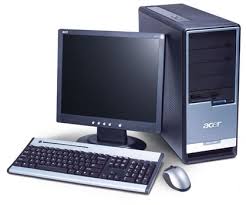What is a Computer?
A computer is an electronic device that processes data,
performing calculations and other tasks based on instructions (programs). It
takes raw data as input, processes it, and provides meaningful information as
output. Computers are used for a wide range of applications, from simple
calculations to complex tasks like scientific research etc.
Types of computer
Here are the different types of computers categorized based
on their size, purpose, and functionality.
1.
Based on Size & Performance
(a) Supercomputers:
A supercomputer is a computer with high computational
capacity designed to solve complex scientific and engineering problems that
require massive amounts of processing power. They are characterized by their
ability to perform trillions of calculations per second, which is measured in
floating-point operations per second (FLOPS). Supercomputers are crucial for
tasks like weather forecasting, scientific simulations, and artificial
intelligence research.
Example: Fugaku (Japan), PARAM (India), IBM Summit (USA).
(b) Mainframe Computers:
Mainframe computers are large, powerful, high-performance
computers primarily used by large organizations for critical applications like
bulk data processing and transaction processing. They are known for their
reliability, security, and ability to handle massive amounts of data and
transactions in real-time.
Handle millions of transactions (banks, airlines,
government).
Example: IBM zSeries.
(c) Minicomputers:
Computer that was smaller, less expensive, and less
powerful than a mainframe or supercomputer but more expensive and more powerful
than a personal computer. Minicomputers were used for scientific and
engineering computations, business transaction processing, file handling, and
database management.
Minicomputers are Smaller than mainframes but more
powerful than PCs.
They are used in small businesses, hospitals, and
universities.
Example: IBM AS/400 (now IBM Power Systems).
(d) Microcomputers:
Microcomputer is a small, relatively inexpensive computer
with a microprocessor as its central processing unit (CPU). It typically
includes memory (RAM and ROM), input/output (I/O) circuitry, and is designed
for individual use. Microcomputers are commonly known as personal computers
(PCs) and are widely used in various applications.
Most common type (used at home, school, offices).
Example: Desktop Computers, Laptops, Tablets
2.
Based on Purpose
(a) General-Purpose Computers
A general-purpose computer refers to a device designed to
perform a wide range of tasks and applications, rather than being limited to
specific functions. It is a versatile computing machine that can be programmed
to execute various software programs, handle diverse data types, and perform
different operations.
Example: Laptops, Desktops, Smartphones.
(b) Special-Purpose Computers
Special-purpose computers are designed to perform
specific, limited tasks, unlike general-purpose computers which can handle a
wide variety of tasks. They are often optimized for speed, reliability, and
efficiency in their designated function. Examples include ATMs, GPS devices,
and embedded systems in vehicles or medical equipment.
Example: ATMs, Weather forecasting systems, Traffic
control systems.
3. Based on Functionality
(a) Analog Computers
An analog computer is a type of computing device that
uses continuously variable physical quantities, like electrical voltage or
mechanical motion, to represent and process data, rather than discrete
numerical values.
Example: Thermometer, Speedometer.
(b) Digital Computers
Digital computers are electronic devices that process
information using discrete values, typically represented in binary code (0s and
1s). They perform calculations and logical operations at high speed, enabling a
wide range of applications from basic arithmetic to complex scientific
simulations.
Process data in binary (0s & 1s).
Most modern computers (PCs, smartphones) are digital.
(c) Hybrid Computers
Hybrid computers are systems that combine the features of
both analog and digital computers. They leverage the strengths of both to
handle a wide range of computational tasks efficiently. Analog components excel
at processing continuous data and solving complex mathematical problems, like
differential equations, while digital components handle logical operations and
numerical computations.
Combination of Analog + Digital.
Used in hospitals (ECG machines), space missions.
4. Other Types
Workstations (High-performance PCs for engineers,
designers).
Embedded Computers (Inside devices like cars, washing
machines).
Quantum Computers (Future tech, uses qubits for ultra-fast
calculations).





